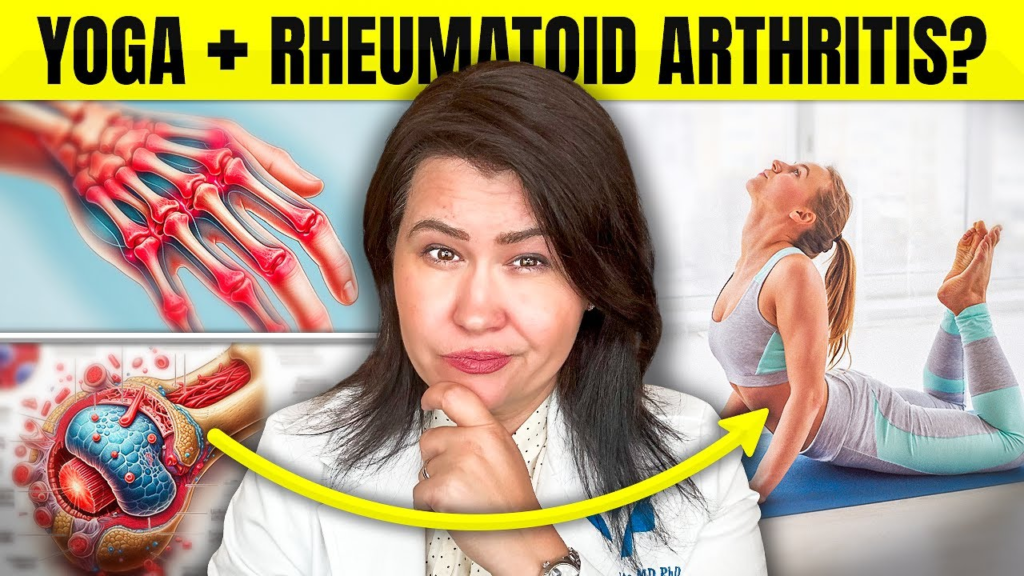
Explore 7 yoga poses with Cori Gramescu, an internationally acclaimed fitness trainer, in this beginner-friendly video designed to ease joint pain and relieve arthritis and rheumatoid arthritis sufferers.
In this image, abnormal synovial tissue is shot through with excessive tissue growth, including blood vessels (in magenta). Synovium should be thin and smooth. CREDIT Bai et al.
Treatment for rheumatoid arthritis (RA) has come a long way in recent years. In many cases, a battery of medications can now successfully stymy the inflammatory cells that cause swelling and pain when they infiltrate tissues around the joints.
Yet for some reason, about 20% of patients with painful, visibly swollen joints consistently get no relief from multiple rounds of even the strongest of these anti-inflammatory drugs.
Surgical interventions intended to remove inflamed tissue have revealed why: “In some cases, their joints aren’t actually inflamed,” says co-senior author Dana Orange, an associate professor of clinical investigation in Rockefeller’s Laboratory of Molecular Neuro-oncology. “With these patients, if you press on the joint, it feels mushy and thick to the touch, but it’s not caused by the infiltrating immune cells. They have excessive tissue growth, but without inflammation. So why are they experiencing pain?”
She and her colleagues suggest an explanation in a new paper in Science Translational Medicine. These patients have a suite of 815 genes that activate abnormal growth of sensory neurons in tissues that cushion the affected joints.
“These 815 genes are rewiring the sensory nerves, which explains why anti-inflammatory drugs don’t work to alleviate pain for these patients,” says Orange. The findings may lead to new treatments for these outliers.
A puzzling disconnection
Rheumatoid arthritis is a tricky chronic disease. Its symptoms—stiffness, tenderness, swelling, limited motion, and pain—slowly emerge in the hands, wrists, feet, and other joints. It occurs symmetrically (not just in one hand but in both, for instance) and sporadically, with irregular flare-ups. Extreme fatigue and depression are also common.
Most cases of RA are caused by products of immune cells such as cytokines, bradykinins, or prostanoids invading the synovium—a soft tissue lining the joints—where they bind to damage-sensing pain receptors. Drugs that target immune mediators have made RA a far more tolerable condition for most, but those suffering from the disconnection between inflammation and ache haven’t benefitted.
Doctors often prescribe these patients drug after anti-inflammatory drug in an ultimately fruitless attempt to give relief. As a result, “we are subjecting some patients to a lot of medications that cause immunosuppression and yet have little chance of making their symptoms better,” Orange says.
She and her colleagues sought answers in the genes expressed in the joint tissue samples of these patients.
Genetic culprits
The researchers looked at tissue samples and self-reported pain reports from 39 patients with RA who had pain but little inflammation. They also developed a machine-learning analysis that they coined graph-based gene expression module identification (GbGMI).
GbGMI tests every possible combination of genes in a dataset to determine the optimal set of genes that together associate with a targeted clinical feature—in this case, pain.
Using RNA sequencing, the researchers found that of the 15,000 genes expressed in the tissue samples, about 2,200 had increased expression in the 39 patients. Using GbGMI, they identified 815 genes that together associated with patient reports of pain.
“This is a challenging problem, because we have a large number of genes but a limited number of patients,” says co-senior author Fei Wang, professor of population health sciences and founding director of the Institute of Artificial Intelligence for Digital Health at Weill Cornell Medicine. “The graph-based approach we used effectively explored the collective associations between a gene set and patient-reported pain.”
Single cell sequencing analysis found that of the four types of fibroblasts in synovial tissue, CD55+ fibroblasts exhibited the highest expression of pain-associated genes. Located in the outer synovial lining, CD55+ cells secrete synovial fluid, allowing for frictionless joint movement. They also expressed the NTN4 gene, which codes for a protein called Netrin-4. Proteins in the netrin family guide axon growth paths and promote new vascular growth.
Surprising pain pathways
These genes, it turned out, were enriched in pathways that are important for neuron axon growth, the researchers discovered. The keys to sensation, sensory neurons receive and transmit information to the central nervous system. Axons are the tendrils that branch out from them into tissues.
“That led us to hypothesize that perhaps the fibroblasts are producing things that alter the growth of sensory nerves,” Orange says.
But what role was the protein playing in the sensation of pain?
To find out, they grew neurons in vitro and then doused them with Netrin-4, which sparked the sprouting and branching of CGRP+ (gene-related peptide) pain receptors. It’s the first time that Netrin-4 has been shown to alter the growth of pain-sensitive neurons, she notes.
Imaging of RA synovial tissue also revealed an overabundance of blood vessels, which feed and nurture new cells. These vessels were encased by CGRP+ sensory nerve fibers and were growing towards the lining fibroblasts in areas of excessive tissue growth, or hyperplasia. This process likely leads to the squishy swelling that many rheumatologists and surgeons have mistaken for inflammation.
Better drugs
In the future, the researchers aim to home in on other products that fibroblasts may be producing that can affect the growth of pain-sensitive neurons. They’ll also delve into the other types of sensory nerves that might be affected.
“We studied one type, but there are about a dozen. We don’t know if all nerves are affected equally. And we don’t want to block all sensation. Sensory nerves are important for knowing that you should avoid certain movements and the position of your joint in space, for instance,” Orange says.
“We want to drill down on those details so that hopefully we can come up with other treatments for patients who don’t have a lot of inflammation. Right now, they’re taking medications that can cost $70,000 a year but have no chance of working. We must do a better job of getting the right drug to the right patient.”

Combining pelvic floor exercises with behavioural therapy could be more effective than current medical treatments at helping men with frequent urges to urinate, new research in men has found.
The results reveal that an app-based therapy significantly improves the lower urinary tract symptoms that many millions of men experience—hesitancy, straining, frequent urges to urinate, and effective bladder emptying. The full trial results are expected to be published later this year.
This could be useful to people with multiple sclerosis, diabetes, rheumatoid arthritis, and other conditions, as well as to the general population.
Carried out in Germany, this is the world’s first randomised controlled trial to look at combining pelvic floor training, behavioural therapy and bladder control techniques for mild, moderate and severe bladder emptying disorders in men, all delivered as an app-based therapeutic.
Bladder emptying disorders can start to appear from the age of 30 and typically affect a large proportion of men aged over 50.
While clinical guidelines recommend physiotherapy, behavioural therapy and lifestyle changes as a first-line treatment, clinicians often neglect them due to a lack of available evidence. Several unpleasant side effects are associated with the few drugs available, and surgery is only advised for those with severe symptoms.
Professor Christian Gratzke, from University Hospital Freiburg in Germany, who co-led the trial, explains: “Frequent urges to urinate and issues emptying the bladder are the most prevalent urinary conditions we see in men after urinary tract infections. While some drugs are available, they don’t tend to be effective, and up until now, there’s been little data available to back physiotherapy. We’re confident that we now have that data, and making this form of therapy available digitally could be a game changer for the millions of men who struggle day-to-day with issues emptying their bladder.”
The researchers recruited 237 men aged 18 across Germany into their 12-week study. Half the men were randomised to receive standard medical care, while the other half were given access to the Kranus Lutera app-based therapy alongside standard care. These participants were asked to record a urination diary, which was used to inform their treatment, and complete questionnaires about their symptoms’ severity and overall quality of life.
After 12 weeks, the trial found significant and clinically meaningful improvements in symptoms and quality of life measures from participants given the app-based therapy, who reported an average seven-point increase in symptom scores compared to those in the control group.
The study found that app-based therapy was more effective than medical therapy. No patients reported any side effects or challenges accessing the smartphone app.
The findings challenge the dogma of the 1980s and 1990s, when prostrate surgery was the first line of treatment for an overactive bladder, and offer a welcome alternative to drugs, say the researchers.
“Many men with bladder emptying disorders are ageing and have other medical conditions that require drug treatments,” says Professor Gratzke. “The limited drugs we have available aren’t suitable for these patients due to their side effects. For those with mild-to-moderate urinary symptoms, this digital therapy is without side effects and improves symptoms by a magnitude we have not seen before. Simply strengthening the pelvic floor makes all the difference, it’s a no brainer.”
Jean-Nicolas Cornu, Professor of Urology at the Charles Nicolle Hospital in France and member of the EAU Scientific Congress Office, said: “There has been little to no evidence to support training men to better control their bladders, despite this being recommended in clinical guidelines. This is the first randomised controlled trial looking at physiotherapy and behavioural therapy for bladder emptying disorders, and it shows a very positive effect over conventional drug treatment.
“We now need a bigger trial looking at the longer-term effect of this app-based therapy after 12 weeks for different forms of bladder emptying disorders. If offered widely, this treatment could dramatically change clinical practice, and could relieve symptoms without exposing patients to drugs. We could save a lot of unnecessary prescriptions for drugs that tend to be of little benefit.”
The researchers compared data from men whose symptoms were due to overactive bladder with those whose symptoms were due to an enlarged prostate. They found that both groups benefited from the therapy. However, it did not compare the effect of therapy on different forms of bladder emptying disorder.